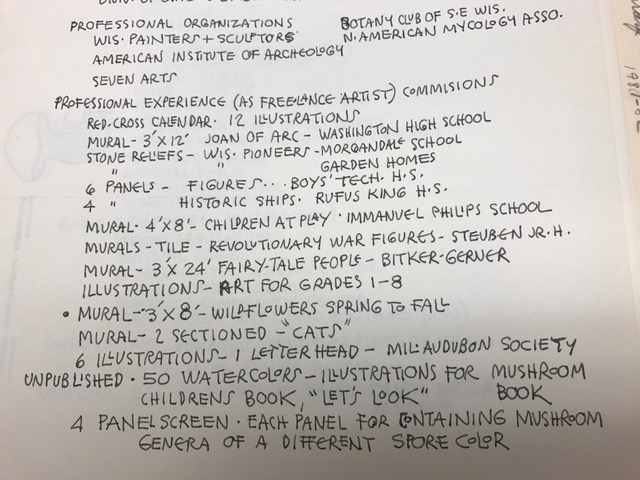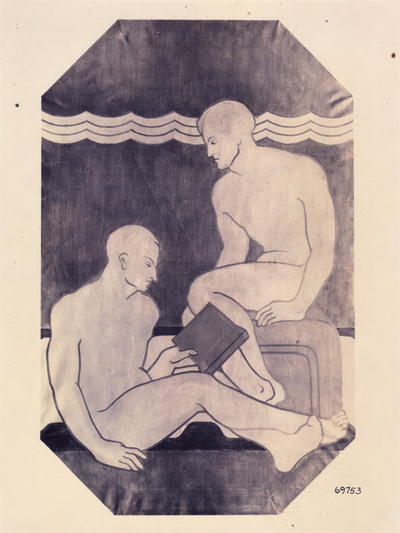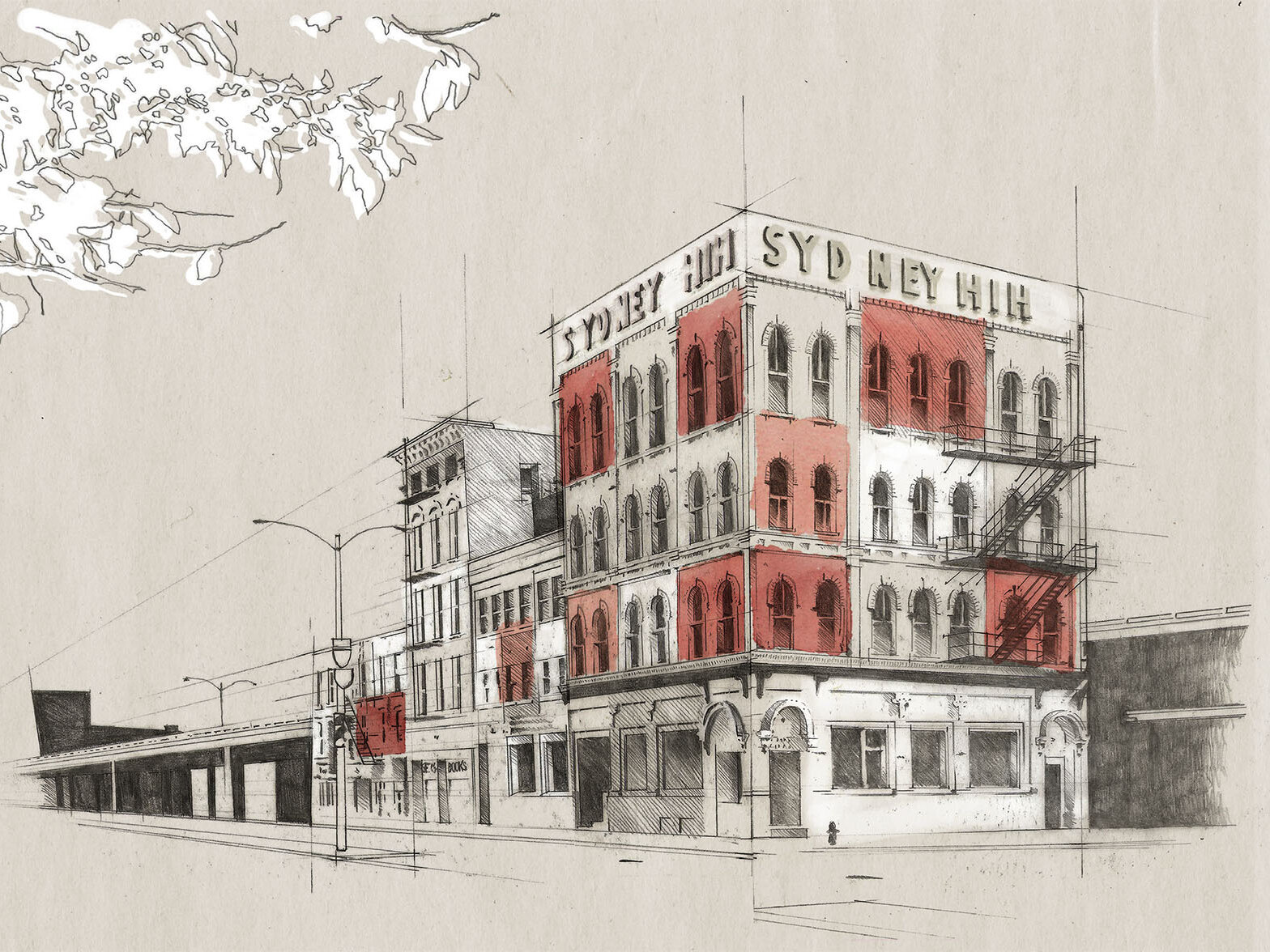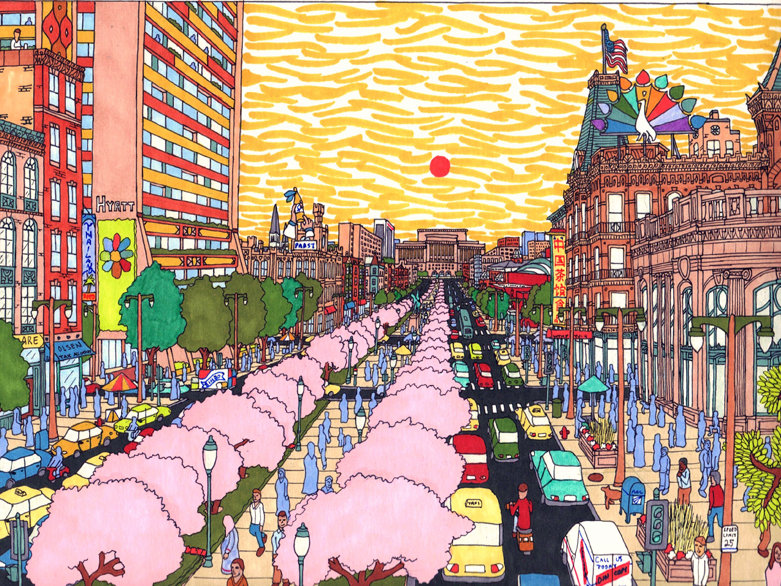In January 2016, I received a note from landscape architect Nancy Aten, who was scanning works by Milwaukee artist Gertrude Kundman Erskine to be included in Erskine’s archive, when she came upon 8x10 photographs of a series of six works that especially caught her attention.
"They look like paintings on canvas," she said. "They look like they might be murals for a school."
I then posted this article on Jan. 11, 2016 asking readers if they could identify the location of the works. Just yesterday, Sept. 21, Aten wrote to let me know the works had been identified. Therefore, I've adapted this post to reflect the new scholarship, so read on to find out where they were located...
In 1955, the Milwaukee Sentinel called Erskine – whose nickname was Tula – a, "versatile, purposeful, slender, red-haired Milwaukee artist who is intensely meticulous and thorough in everything she does whether it be housekeeping (!), painting, sculptoring, doing research into art techniques and media or into botany, sewing her own clothes, carrying out her duties as board member for the Wisconsin Painters and Sculptors Society and as publicity chairman for the Audubon Society of Wisconsin."

Erskine, a Washington High School grad, had regularly shown her work at the Milwaukee Art Institute, art competitions at the Wisconsin Salon and State Fair and at art museums as far-flung as Syracuse, N.Y.
There were no notes attached that would identify the works Aten found – which are owned by the Urban Ecology Center – nor where they might have been painted, nor their dimensions.
"They were tucked in an old portfolio, and have glue marks on the back like they were once pasted in," she said. "The portfolio is really loosely arranged, so it's hard to attribute chronology, but they were with other items that I would guess makes them circa 1930s or early ‘40s."
Aten believed the style of the works also fits with that time frame based on what she knows about the timeline of Erskine’s career. She also noted that her signature, GK, can be seen on a couple of the works.
"She was married to James Erskine in 1949 after which she always seemed to use GKE," said Aten. "So, pre-1949 for sure."
Aten said that there are other items in the same section of the files, including clippings from children’s books that Erskine may have used when she created the terra cotta tiles showing fairy tale scenes that are on the exterior of the Emanuel Philipp Elementary School, 4310 N. 16th St.
In addition to her work at Philipp, Erskine – a Washington High School grad and erstwhile art teacher at Girls Tech (now the Milwaukee Rescue Mission) and Rufus King High Schools – did a mural at Steuben (now French Immersion) and bas-relief doorway designs at Morgandale and Garden Homes (now Barbee Montessori) Schools.

Erskine's resume, written in her own hand. (PHOTO: Chris Young)
Erskine died in 2000.
Here are the drawings of the murals:





Thanks to an undated Journal article pasted into a scrapbook lent to Aten by Erskine's niece Jane Watts, the location of the works has finally been uncovered.
"Six murals, the work of Miss Gertrude Kundman, a senior at Milwaukee State Teachers' College, have recently been placed in the new auditorium of the Boys' Technical High School addition." the article said. The addition was built in 1930.
"The six murals, which were designed by Miss Kundman, represent sculpture, literature, music, oratory, athletics and manual arts."
The article noted that MPS' in-house architect Guy E. Wiley and the State Teachers' College's Mr. (Gustave) Moeller, "assisted in the designing and planing of the paintings, although the execution of the work was entirely done by (Kundman)."
One interesting note in the article is a reference to the fact that Tula's great-grandfather was a sculptor and that, at the time of the article, one of his works – a monument to a naval victory – stood in a square in Vienna.
Karl Kundman's work – which honors Wilhelm von Tegetthoff – is still there today.
The paper quoted the artist, too:
"The reason I have not represented the different trades, which would seem to be appropriate for a technical high school, is because after asking the opinion of several persons I found that most members of the student body, since they worked with tools a part of the day, wished to see something different.
"The reason that pictures are made in simple design is that they will harmonize with the architecture of the room. This is one of the essentials of modern art.
"I do not think of modern art as a drawing of angles and straight lines as it appears to amateurs, but I think of it as a drawing of simplicity. In that objective my paintings for your school would also be modern art. These murals, I am sure, would also conform to the ideas of Mr. Frank Lloyd Wright, for he believes that paintings should be a part of the architecture of the building and should be make into two dimensions as these are, instead of three, as an ordinary painting is made.
"The reason the figures depicted in the paintings are nude is because these figures are not to represent an certain period of life. Since clothing changes in style, the murals would look old-fashioned in later years."
Unless they were salvaged – and I don't know that they were – these Erskine paintings were likely lost when the old Tech building was razed in 2006.
In related news, the Urban Ecology Center in Riverside Park will open a special exhibit of Erksine's later naturalist work beginning on Thursday, Oct. 12. The show runs through December.
Born in Brooklyn, N.Y., where he lived until he was 17, Bobby received his BA-Mass Communications from UWM in 1989 and has lived in Walker's Point, Bay View, Enderis Park, South Milwaukee and on the East Side.
He has published three non-fiction books in Italy – including one about an event in Milwaukee history, which was published in the U.S. in autumn 2010. Four more books, all about Milwaukee, have been published by The History Press.
With his most recent band, The Yell Leaders, Bobby released four LPs and had a songs featured in episodes of TV's "Party of Five" and "Dawson's Creek," and films in Japan, South America and the U.S. The Yell Leaders were named the best unsigned band in their region by VH-1 as part of its Rock Across America 1998 Tour. Most recently, the band contributed tracks to a UK vinyl/CD tribute to the Redskins and collaborated on a track with Italian novelist Enrico Remmert.
He's produced three installments of the "OMCD" series of local music compilations for OnMilwaukee.com and in 2007 produced a CD of Italian music and poetry.
In 2005, he was awarded the City of Asti's (Italy) Journalism Prize for his work focusing on that area. He has also won awards from the Milwaukee Press Club.
He has be heard on 88Nine Radio Milwaukee talking about his "Urban Spelunking" series of stories, in that station's most popular podcast.







